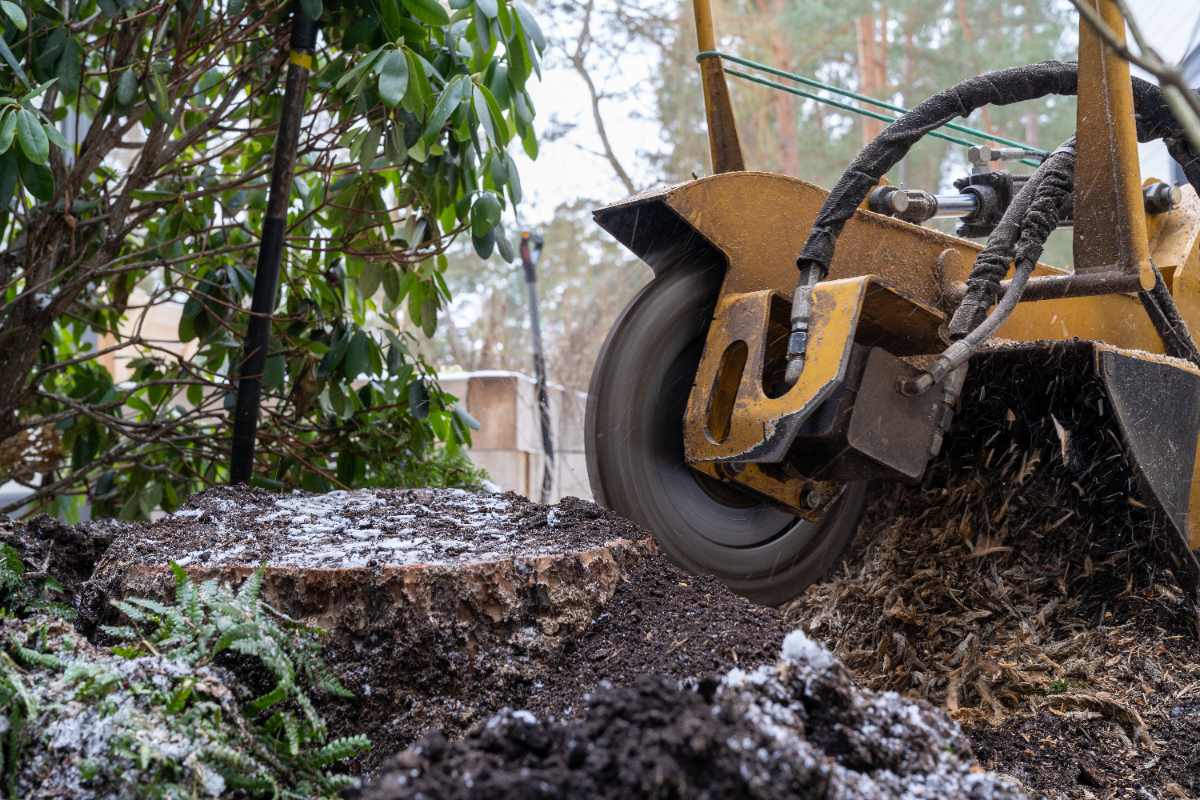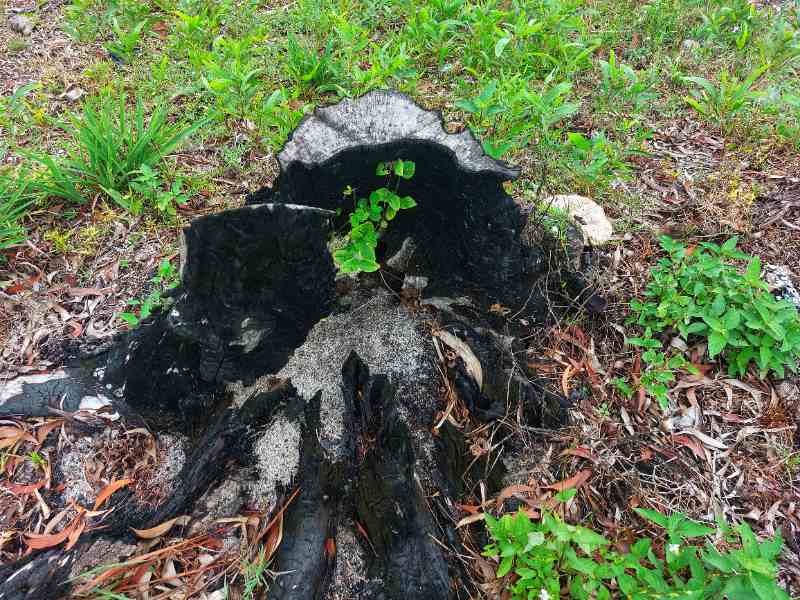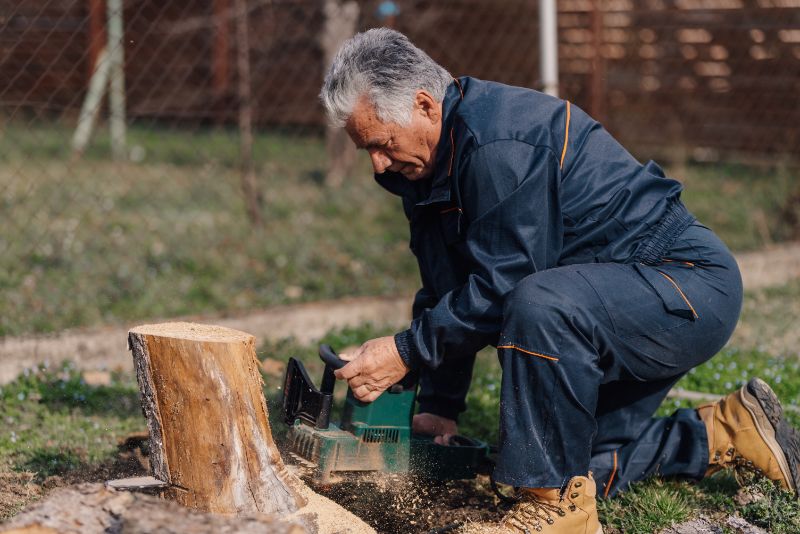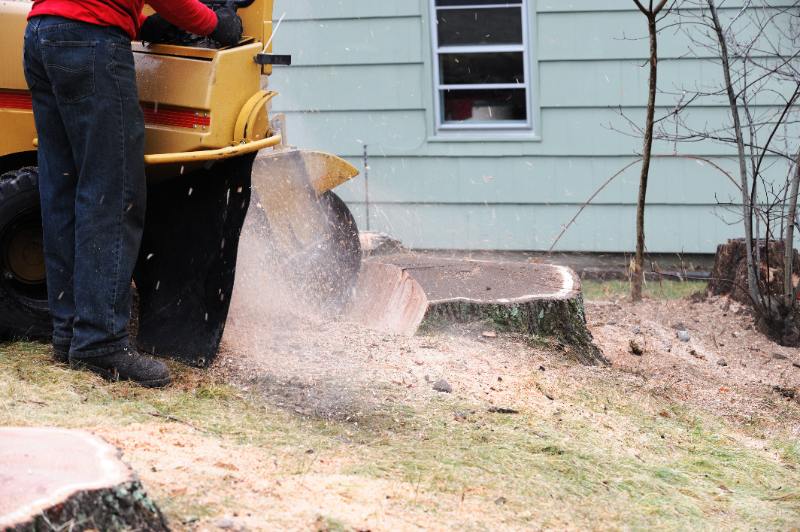
You must kill a tree stump to prevent it from attracting plant diseases, fungi, and pests. Apart from manual removal and grinding, other ways to kill a tree stump include using Epsom salt or vinegar.
In this guide, we’ll discuss all methods for killing a tree stump, including the tools you’ll need, an overview of each process, and even the timeline for completion. We’ll also share expert tips and a decision calculator to help you choose the right approach.
| Project Difficulty: Easy to difficult, depending on the method Estimated Time to Complete: 1 day to more than 1 year, depending on the chosen method Project Cost: Low to high, depending on the method used: DIY costs around $10 to $120, while professional stump removal costs between $175 and $516. |
Decision Calculator for Killing a Tree Stump
Epsom Salts
Using Epsom salt is a popular and low-impact method for killing small tree stumps. It’s ideal if you can patiently wait 2 to 6 months for the results. This method works by dehydrating the stump, gradually drying it until it rots and dies.
Take extra care when using Epsom salt. Even though it’s simply magnesium sulfate, Linda Chalker-Scott, Extension urban horticulturist at Washington State University, says, “Misuse of magnesium sulfate causes nutrient problems in the soil.”
| Difficulty: Easy Timeline: 2-6 months Cost: Low (under $50) Effectiveness: Moderate Stump size: <12 inches in diameter |
Materials:
- Epsom salt
- Power drill with a large drill bit (at least 1 inch)
- Water
- A tarp or plastic sheet
- Garden gloves
Step-by-Step Process:
- Use a drill to bore several holes in the top and sides of the stump. Holes should be about 6 to 12 inches deep and 1 inch wide, spaced a few inches apart.
- Pour Epsom salt into each hole until about 3/4 full. Be careful with this step, as high concentrations of Epsom salt can kill your lawn.
- Add a small amount of water to each hole to help the stump absorb the salt.
- Cover the stump with a tarp to block sunlight and help retain moisture.
- Reapply Epsom salt and water every 2 to 3 weeks.
- After 2 to 6 months, the stump will begin to dry out and decompose. You can chip away the softened wood as it breaks down.
Pro Tip: For less material to treat, cut off (using a chainsaw) as much of the tree stump as you can. This also applies to the other methods.
Note: After the stump removal, hire a LawnStarter landscaping pro to plant a new tree in a more suitable location. You can also ask them for help if you want to plant grass seed to restore the lawn where you removed the stump.
See Related: Tree Root Removal: A How-to Guide
Rock Salt
Similar to Epsom salt, rock salt is also ideal for killing old or small tree stumps. It’s especially useful on a stump that has started regrowing, as it can dehydrate the stump and surrounding roots more aggressively.
Rock salt can penetrate deep into the root system and stop future growth. So, this is a solid option for homeowners trying to figure out how to kill a tree stump that keeps sprouting new growth.
| Difficulty: Easy Timeline: 3-6 months Cost: Low (under $50) Effectiveness: Moderate Stump size: <12 inches in diameter |
Materials:
- Rock salt (coarse)
- Power drill with a large drill bit
- Water
- Mulch
- Protective gloves
Step-by-Step Process:
- Drill several 1-inch-wide holes into the top of the stump. They must be 6 to 12 inches deep and a few inches apart.
- Fill each hole with rock salt until it’s 3/4 full. Be careful, as high amounts of rock salt can also kill grass.
- Pour a small amount of water into each hole to help the salt dissolve and soak into the wood.
- Cover the stump with a tarp to limit sunlight and retain moisture.
- Reapply rock salt every few weeks.
- As the stump begins to dry out, chip away at the softening wood.
Vinegar

For killing smaller or freshly cut stumps, vinegar can be an eco-friendly and cost-effective option. The acetic acid in vinegar helps dry out and kill the stump over time.
This method is best for DIYers looking for ways to kill a tree stump using everyday household items. And if there are weeds growing around the tree stump, you can kill two birds with one stone, as vinegar can also kill weeds.
| Difficulty: Easy Timeline: 6-12 months Cost: Low (under $50) Effectiveness: Low to moderate Stump size: <12 inches in diameter |
Materials:
- White vinegar (horticultural vinegar with 20% acetic acid)
- Power drill with a large drill bit
- Spray bottle or funnel
- Plastic wrap or tarp
- Gloves and eye protection
Caution: 20% acetic acid can cause eye and skin damage, so goggles and skin protection are paramount.
Step-by-Step Process:
- Drill 1-inch holes on the top surface of the stump, around 6 to 12 inches deep.
- Pour vinegar into each hole using a funnel or spray bottle.
- Saturate any exposed roots or the outer surface of the stump with vinegar.
- Cover the stump with plastic wrap or tarp to retain moisture and heat, which intensifies the vinegar’s effect.
- Reapply vinegar every 1 to 2 weeks until the stump starts to dry and rot.
- As the wood softens, remove the stump in chunks or allow it to decompose in place.
Naturally (Covering It)
While it can take months, letting the stump decompose naturally is a low-cost option. It’s one of the simplest methods of speeding up natural decay, as it blocks sunlight and traps moisture, encouraging fungi and microorganisms to break down the wood.
If you want to kill a tree stump naturally, this method is chemical-free and environmentally safe — it just takes patience.
| Difficulty: Easy Timeline: 6 months to 1+ year Cost: Low (under $50) Effectiveness: Low to moderate Stump size: Over 24 inches in diameter |
Materials:
- Heavy-duty tarp, plastic sheeting, or a thick rubber mat
- Rocks, bricks, or landscape staples
- Mulch, soil, or organic material
Step-by-Step Process:
- Cut the stump as close to the ground as possible,” says Chalker-Scott.
- Next, she says, “Drill holes into the surface, and sprinkle soil from the site on top. Water it in. The fungal spores in the soil will initiate natural decomposition.” If you don’t have extra soil around the site, a natural mulch, like wood chips, or compost also works.
- Cover the stump (including the exposed roots) completely with a tarp, plastic sheet, or rubber mat. (Chalker-Scott says that covering a tree stump will prevent light from stimulating resprouting.)
- Secure the cover with heavy objects like bricks or rocks.
- Leave the stump covered for several months to over a year.
- Check occasionally for softening or fungal growth.
- Chip away as the wood decays and cut any sprouting that may start popping near its base.
Note: The above steps will help speed up the natural rotting process. But you can repeat them every few weeks (or when the mulch/soil becomes too dry) to speed up decomposition even more.
Controlled Burn

Burning a tree stump is a faster way to get results if local regulations allow it. It’s not for everyone, but for some homeowners, fire does the job quickly and effectively.
This method can quickly reduce a dry, seasoned stump (left to dry out and decompose for at least a year after cutting it down) to ash. But it must be done safely.
| Difficulty: Moderate to high Timeline: Less than 24 hours Cost: Low to moderate (under $200) Effectiveness: High Stump size: Over 24 inches in diameter |
Materials:
- Power drill with a large drill bit
- Kerosene or charcoal lighter fluid (never gasoline)
- Firewood or charcoal
- Shovel or rake
- Metal mesh or fire ring
- Garden hose or fire extinguisher
- Safety gloves, goggles, and fire-resistant clothing
- Topsoil
Step-by-Step Process:
- Drill deep holes into the stump.
- Pour kerosene or charcoal lighter fluid into the holes, and let it soak in overnight.
- Stack firewood or charcoal on top of the stump and ignite it.
- Monitor the fire closely at all times, and use a mesh or ring to help contain the flames.
- Depending on the stump size, it can take anywhere from 12 hours to a few days to completely reduce the stump to ashes. So, you may have to repeat the process until the stump is gone.
- Shovel out any remaining debris and fill in the hole with topsoil.
Safety Tip: Have a garden hose or fire extinguisher ready in case the fire gets out of control.
Chemical Treatments
If you can’t use the controlled burn method, chemical stump killers can also help break down stumps quickly with little effort. They also work well for getting rid of the roots.
| Difficulty: Easy Timeline: 4-8 weeks Cost: Low to moderate ($10 – $200) Effectiveness: High Stump size: Over 24 inches in diameter |
Materials:
- Commercial stump remover or herbicide (potassium nitrate-based or glyphosate/triclopyr)
- Power drill with a large drill bit
- Funnel
- Water
- Tarp (optional)
- Protective gloves and goggles
Step-by-Step Process:
- Drill holes in the stump about 6 to 12 inches deep and spaced a few inches apart.
- Following the manufacturer’s instructions, use a funnel to pour the chemical stump remover into the holes.
- Add water (as specified on the label) to help the chemicals soak in and activate.
- Cover the stump with a tarp to trap moisture and speed up decay (optional).
- Let the chemical sit for 4 to 8 weeks, depending on the product.
- Once the stump becomes soft and spongy, remove it by chipping or digging.
Manual Removal

Even if you kill a tree stump, it’s like a zombie — dead, but not really gone. To get rid of it for good, manual removal is the old-school method. You’ll dig, cut, and yank until there’s nothing left of the stump. It’s hard work, but you get instant results.
| Difficulty: High Timeline: Few hours to 2 days Cost: Low to moderate (under $200) Effectiveness: High Stump size: 12 to 24 inches in diameter |
Materials:
- Shovel
- Mattock or pickaxe
- Loppers or saw
- Reciprocating saw or chainsaw (optional for thick roots)
- Digging bar
- Work gloves and eye protection
Step-by-Step Process:
- Use a shovel or pickaxe to dig around the stump, exposing the main roots.
- Cut through exposed roots with a chainsaw, loppers, or a mattock.
- Continue cutting and prying until the entire stump is loose and can be pulled out.
Here’s a quick video on manually removing a stump:
Grinding
Stump grinding is the most efficient way to get rid of a tree stump. It involves using a powerful stump grinder to chip the stump down into wood shavings, well below ground level.

While this method is quick and effective, it does require renting specialized equipment (around $178 to $364 per day), which can add to the cost and difficulty.
Safety Precaution: Stump grinders can make wood chips and rocks fly everywhere and can even cut utility lines. So, if you don’t have the skills needed to operate a stump grinder, you can opt to hire a tree care pro instead. Professional stump grinding costs around $131 to $438, but the job will get done safely and much faster.
| Difficulty: High Timeline: Few hours to 1 day Cost: Moderate to high ($130 to over $200) Effectiveness: High Stump size: Over 24 inches in diameter |
Materials:
- Stump grinder
- Safety gloves, googles, hearing protection, steel-toe boots
- Shovel and rake
- Wheelbarrow (for hauling away chips)
- Soil or mulch
Step-by-Step Process:
- Remove any rocks or debris around the stump.
- Start the stump grinder and slowly lower the blade into the stump.
- Move the grinder side to side to chip away the wood, working several inches below ground level.
- Once the stump is fully ground, shovel out the chips and fill the hole with soil or mulch. You can even use these wood chips as mulch for your flowerbed.
Here’s a quick tutorial on using a stump grinder:
FAQ About Killing Tree Stumps
It can take anywhere from 6 months to over a year for a tree stump to fully rot naturally.
Yes, tree stump removal can potentially damage your lawn. Large equipment like stump grinders can leave ruts on your lawn, while burning and using natural solutions or chemical treatments may affect nearby grass.
No, you must wait at least 8 weeks to a year before planting a new tree. Also, test the soil for pH and nutrient levels to ensure optimal planting conditions.
Let the Pros Take Care of Your Tree Stump Woes
Even small tree stumps can sprout new growth and come back to life. But you have several options to kill that stubborn stump — some take time and patience, others need muscle or chemicals.
If tackling a stump sounds like more work than you’re up for, you’re not alone. Most homeowners hire a LawnStarter tree care pro to remove a tree stump quickly and safely.
Sources:
- “How to Remove Tree Stumps.” By Aaron Steil, consumer horticulture extension specialist. Iowa State University Extension and Outreach.
- Linda Chalker-Scott, extension urban horticulturist emerita at Washington State University Puyallup Research and Extension Center. Personal interview.
- “Question: Can I Treat Removed Tree Stumps By Drilling And Applying Copper Sulfate?” By Lindsey Purcell, urban forestry specialist. Purdue University Extension.
- “Stump Removal Following Taking Down Trees.” Oklahoma State University Extension.
Main Image: Grinding a Tree Stump. ImageCredit: Valdis / Adobe Stock